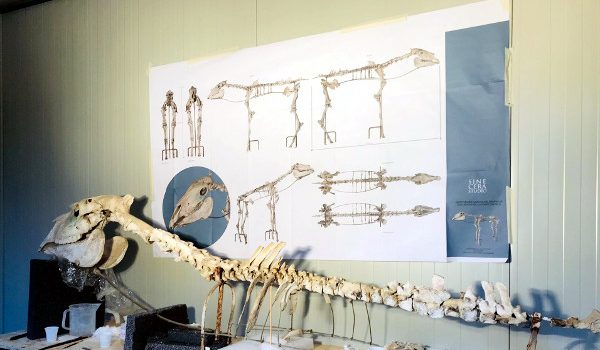The restoration of Maiuri’s horse
The skeleton of a horse discovered in 1938, in an area of the ancient city of Pompeii, is the subject of a restoration and valorisation project undertaken by the Archaeological Park of Pompeii, aimed at recovering and protecting the find.
Upon its restoration and consolidation, by utilising a laser scanner to survey the skeleton it will be possible to create a 3D model for the benefit of the visually impaired, in a new in situ display that is both accessible and inclusive.
The skeleton of the animal, a horse standing 1.34 metres at the withers, which was used for the transport of goods by towing, was discovered by Amedeo Maiuri in 1938 during the excavation of an area to the south of Via dell’Abbondanza. In what was later identified as a stable, a square masonry structure, which was probably a manger, was uncovered first and then a little further on the skull, neck and part of the spine of the horse emerged from the lapilli, before, further down, the rest of the body as well as other organic remains (straw) followed.
Maiuri left the finds in situ - according to the ‘open-air musealisation’ policy, which had already been tested in earlier decades by Superintendent Vittorio Spinazzola - repositioning the horse back onto its feet upon a metal armature, covered by a canopy. Over the course of the decades however, this horse was all but abandoned, and suffered progressive decay. The metal armature itself caused damage to the skeleton too, due to oxidisation which caused the colour of the bones to deteriorate.
For this reason, the Archaeological Park of Pompeii has undertaken its restoration together with a plan for a new display which will allow it to be properly valorised.
The working methodology began with a laser scan of the horse, in order to create a 3D model and subsequently allow the various pieces to be disassembled, prior to restoration, cleaning and consolidation in the laboratory.
At a later stage, there will be an evaluation regarding which missing parts it would be best to reprint by means of a 3D scan. The entire find will be reassembled in a more scientifically correct position, with a new structure and materials, suitable for the microclimate and therefore able to ensure the necessary conditions for the protection of the horse.
A tactile 3D model for the benefit of the visually impaired will also be prepared that can be touched, along with a differentiation between those parts which have been preserved and those which will be reconstructed, in order to assist in understanding the history of this horse, from its discovery to its restoration, together with an explanation in Braille.
“This is a multidisciplinary intervention, which sees restorers and archaeologists working together, supported in every phase of the operation by an archaeozoologist, in order to conduct a true scientific study of the horse, not addressed in the days of Maiuri, which will be able to yield further and important information on the kinds of animals which were used at Pompeii and on their characteristics.” - emphasises Director of the Park Gabriel Zuchtriegel - “The project of valorising the find within its new display will also make it available to all visitors, with a view to maximum accessibility and inclusivity, and raise awareness of the restoration work conducted at the Park”.
Working Group
Project Manager: Luana Toniolo
Director of Works: Stefania Giudice
Director of Restoration Operations: Paola Sabbatucci
Director of Architectural Operations: Arianna Spinosa
Director of Engineering Operations: Armando Santamaria
Ales Accounting support: Amedeo Mercogliano
Archaeozoologist: Natascia Pizzano
DF14 – Restauro Beni Culturali di Debora Fagiani
SineCera Studio – sinecerastudio.it


